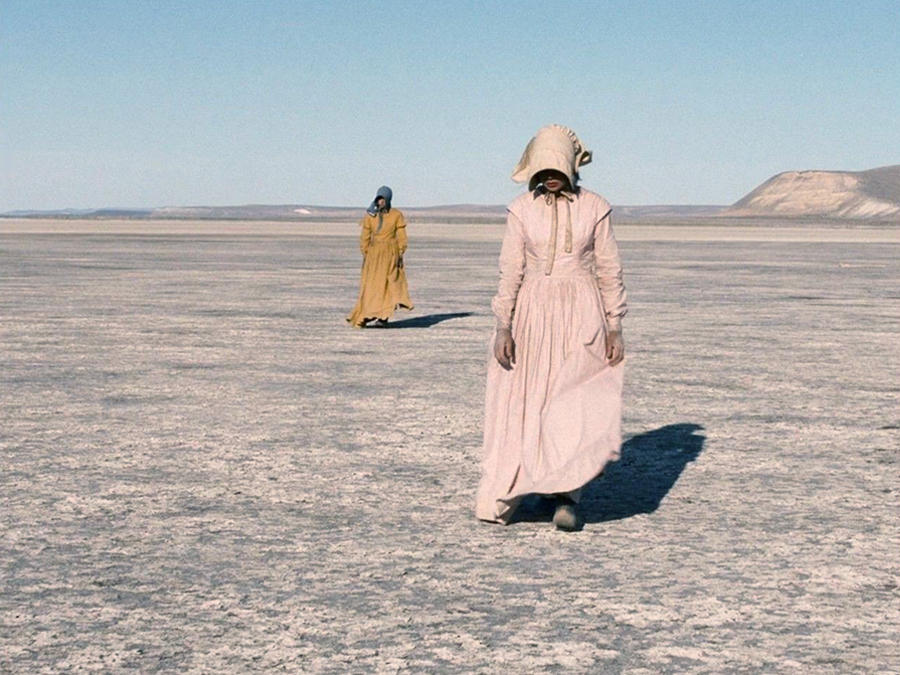
The year is 1845, the earliest days of the Oregon Trail, and a wagon team of three families has hired the mountain man Stephen Meek to guide them over the Cascade Mountains. Claiming to know a short cut, Meek leads the group on an unmarked path across the high plain desert.
“Reichardt's film-making palette is determined by the parched, scorched landscape and the grim faces of those travelling across it. It is a world of tough browns and ochres, pale greys; the blue of the sky is bleached out with glare and haze. And with its long, silent takes (music is used sparingly on the soundtrack), it is a film which compels you to examine the details. For the first 10 minutes, it is entirely wordless, and long stretches will go by in which you can hear only the repeated whine of the wagon wheels as the pioneers grimly trudge along, rather like the squeaky wind-wheel in the famous opening of Sergio Leone's Once Upon a Time in the West. Sometimes, this sound is only just audible above the roar of the wind across the plains.”
Peter Bradshaw1
“An absence of subtitles for the words of the Cayuse person in Meek’s Cutoff, for instance, asks the audience to lend an ear to the sounds, rather than the sentences, which make up dialogue: an oral relation growing aural, material, sensorial. For any non-Cayuse spectators and characters, a lack of linguistic understanding functions to instil some form of deferential distance towards the Native American other. While women within and without the film inhabit their own ‘axes of exclusion’ (to quote Mayer’s helpful phrase), these axes intersect little with those of the Cayuse. With Reichardt, we accept that we cannot proclaim to know profoundly their exclusion, their experiences.”
Laura Staab2
“At a key moment in Meek’s Cutoff, a significant conversation takes place virtually out of earshot. Three men debate their next course of action with the eponymous fur trapper who has led their wagon train astray; in watching the discussion in long shot, we assume the vantage point of the men’s wives. Sound levels are appropriate: like the women, we have to listen intently to pick out words from the exchange. (...)
Reichardt doesn’t so much streamline or typify her characters as allow them to emerge, gradually, from their environment. Again, if we can take the severity of their environment for granted, we can also count on their built-in ruggedness. Stephen Meek boasts: “I live with this world, not just in it.” Here, notions of dwelling are paramount. The dissolves employed early on in Meek’s Cutoff are so slow that they mark passages in space as much as they do time: rather than convey landscape as successive, they show two landscapes seemingly merging.”
Michael Pattison3

“After the group meets a stranger – played by Apsaalooke/Crow actor Rod Rondeaux and credited in the film as “the Indian” – Emily Tetherow (Michelle Williams) sews the ripped seam of his shoe in exchange for safe passage to water. “I want him to owe me something,” Tetherow explains. As she binds the fabric together and reconstructs his boot one stroke at a time, the unsolicited gesture becomes a form of chaining.
To push through the thick leather, Tetherow uses a heavy pin and thimble to protect her fingertips as she guides the stiff thread around the folds of the stranger’s shoe. Piercing the fabric, manipulating the thread, and knotting it in place – stitching with a needle and thread can involve violent steps. In this fantasy of the Oregon Trail, the repetitive action of sewing echoes in the fabric of the film. While embroidery signifies the collective trail in the title card, the movement of Tetherow’s needle initiates a bargain for mutual survival, strings attached.”
Taylor Bradley4
“Reichardt, known for her naturalistic films, says she deliberately stripped the film of excess to focus on the settlers' heightened sensations of time and space in the desert.
“After reading journals [from real settlers making their way across the Oregon Trail] about this whole idea of space and time, I realized that it’s just completely different,” she says. “There’s a trancelike quality about the journey that I haven’t really experienced in tales of going West.” Before filming began, Reichardt set up a pioneer camp in order for her actors to become comfortable around everyday 19th-century chores. “For a week before we started shooting, we learned how to do all of those things to make it look like it was second nature,” Williams says. “We learned how to knit and how to handle yourself around oxen – so those things that look like they might be simple tasks actually had a lot of preparation [and] time around them.”
One of those simple tasks was learning how to wear a bonnet, which extended a foot on either side of her head and cut off her peripheral vision. The idea of the bonnet – and of cutting off space – was also the main reason Reichardt says she chose to shoot Meek’s Cutoff in a 4:3 aspect ratio – rather than a wider perspective.
“I felt like the square [aspect ratio] gave you an idea of the closed view that the women have because of their bonnets,” Reichardt says.””
Terry Gross5
- 1Peter Bradshaw, “Meek’s Cutoff - review”, The Guardian, April 2011.
- 2Laura Staab, “Certain Women and Other Animals: A Symposium on the Cinema of Kelly Reichardt at the British Film Institute London”, Another Gaze, April 2017.
- 3Michael Pattison, “Cows Aren’t Built to Swim: Kelly Reichardt’s Essays on the Unvoiced”, MUBI, August 2016.
- 4Taylor Bradley, “Sewing Spaces / Needlework in Meek’s Cutoff”, The Brooklyn Rail.
- 5Terry Gross in conversation with Kelly Reichardt and Michelle Williams, “Going West: The Making Of ‘Meek’s Cutoff”, NPR, April 2011.

